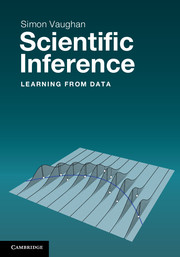Book contents
- Frontmatter
- Dedication
- Contents
- For the student
- For the instructor
- 1 Science and statistical data analysis
- 2 Statistical summaries of data
- 3 Simple statistical inferences
- 4 Probability theory
- 5 Random variables
- 6 Estimation and maximum likelihood
- 7 Significance tests and confidence intervals
- 8 Monte Carlo methods
- Appendix A Getting started with statistical computation
- Appendix B Data case studies
- Appendix C Combinations and permutations
- Appendix D More on confidence intervals
- Appendix E Glossary
- Appendix F Notation
- References
- Index
8 - Monte Carlo methods
Published online by Cambridge University Press: 05 June 2014
- Frontmatter
- Dedication
- Contents
- For the student
- For the instructor
- 1 Science and statistical data analysis
- 2 Statistical summaries of data
- 3 Simple statistical inferences
- 4 Probability theory
- 5 Random variables
- 6 Estimation and maximum likelihood
- 7 Significance tests and confidence intervals
- 8 Monte Carlo methods
- Appendix A Getting started with statistical computation
- Appendix B Data case studies
- Appendix C Combinations and permutations
- Appendix D More on confidence intervals
- Appendix E Glossary
- Appendix F Notation
- References
- Index
Summary
The generation of random numbers is too important to be left to chance.
Title of an article by Coveyou (1969)In the preceding chapters, we have discussed ways to estimate various statistics that summarise data and/or hypotheses, such as sample means and variances, parameters of models, their distributions, confidence intervals and p-values from goodness-of-fit tests. We can calibrate these if we know the sampling distribution of the relevant statistics. That is, we can place the observed value in the distribution expected (for a given hypothesis) and assess whether it is in the expected range or not. For example, in order to compute a p-value from a goodness-of-fit test, we need to know the distribution of the test statistics, or to find the variance (or bias) of some estimator we need to know the sampling distribution of the estimator. These follow from the distribution of the data and the mathematical relationship between the data and the statistic. Often this is difficult, sometimes even impossible, to perform analytically. But the Monte Carlo method makes many of these problems tractable, and provides a powerful tool for analysing data, and understanding the properties of analysis procedures and experiments.
The core of the Monte Carlo method is to generate random data and use this to compute estimates of derived quantities. We can use the Monte Carlo method to evaluate integrals, explore distributions of estimators and estimate any other quantities of sampling distributions.
- Type
- Chapter
- Information
- Scientific InferenceLearning from Data, pp. 169 - 184Publisher: Cambridge University PressPrint publication year: 2013



